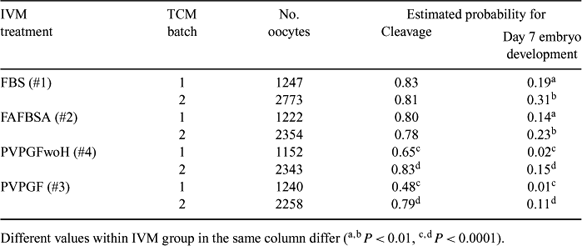297 A CASE REPORT: THE OUTCOME OF IVP MAY BE RELATED TO THE BATCH OF TCM-199 IN IVM
M. Räty A , E. Ketoja A , K. Kananen-Anttila B , K. Korhonen A , J. Matomäki A , M. Halmekytö B and J. Peippo AA MTT Agrifood Research Finland, Animal Production Research, 31600 Jokioinen, Finland
B Institute of Applied Biotechnology, University of Kuopio, 70211 Kuopio, Finland. Email: mervi.raty@mtt.fi
Reproduction, Fertility and Development 17(2) 299-299 https://doi.org/10.1071/RDv17n2Ab297
Submitted: 1 August 2004 Accepted: 1 October 2004 Published: 1 January 2005
Abstract
Chemicals used in bovine IVP may be inhibitory to embryo development (see, e.g., Van Soom A et al. 1994 Theriogenology 41, 325). The present study continued earlier experiments to optimize serum-free IVM protocol for bovine oocytes (Räty M. 2004 Reprod. Fert. Dev. 16, 281). The embryo development rate was much lower in the new experiments than in our previous studies. Thorough testing indicated that the batch of TCM-199 medium used in maturation was the reason for the lower embryo development results. In total, 14,589 abattoir-derived bovine oocytes in 23 batches were matured for 24 h in TCM-199 with glutamax-I (GIBCO, Paisley, UK), 0.25 mM Na-pyruvate, 100 IU mL−1 penicillin, 100 μg mL−1 streptomycin, 10 μg mL−1 LH, 2 μg mL−1 FSH, and 1 μg mL−1 β-estradiol supplemented as follows: (1) 10% FBS (GIBCO, New Zealand); (2) 4 mg mL−1 fatty acid-free albumin (FAFBSA) (Sigma-Aldrich, Helsinki, Finland); (3) 4 mg mL−1 polyvinylpyrrolidone (PVP) (Sigma) + growth factors (GF; 100 ng mL−1 IGF-I + 100 ng mL−1 EGF); or (4) as (3) but without FSH, LH, and β-estradiol (PVPGFwoH). Fertilized oocytes were denuded and cultured in modified SOFaaci + 4 mg mL−1 FAFBSA in 5% O2. (Holm P. et al. 1999 Theriogenology 52, 683–700). Two TCM-199 batches were used in separate IVM runs, batch 1 (Lot#3075638; 10 runs) and batch 2 (Lot#3081334; 13 runs). The statistical analyses were based on generalized linear mixed models. The estimated probabilities for embryo cleavage and development are shown in Table 1. The use of TCM-199 batch 1 resulted in significantly lower embryo development rates than the use of TCM-199 batch 2 in every IVM group studied. PVP IVM groups were the most sensitive for the TCM-199 batch and resulted in reduced embryo cleavage as well as strikingly low Day 7 embryo development. Our results indicate that TCM-199 batch 1 disturbed embryo development. In defined IVM groups (PVP groups), the maturation inhibiting role of TCM-199 batch 1 was seen already at the cleavage stage. It is possible that FBS and FAFBSA may have protected the oocytes to some extent against inhibitory effects of TCM-199. There is evidence for BSA acting as a chelating agent (see, e.g., Flood L.P. and Shirley B. 1991 Mol. Reprod. Dev. 30, 226–231).

|


